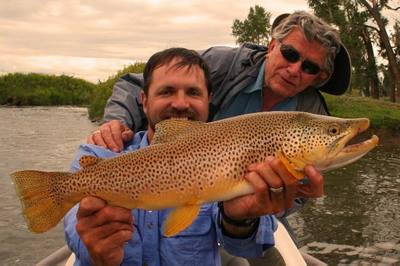Some of the best fishing of the year occurs just after runoff subsides. Post runoff fishing can be very good for a variety of different reasons. First, trout have not been fished to in several weeksit is hard to fish when you are dodging floating debris! Second, water temperatures are hitting the mid 50s (F) and both the aquatic insects and trout are becoming much more active. Third, strong mid river currents push trout close to banks where, effectively concentrating all of the fish in the river into a small zone along the edge of the river. Fourth, several of the best aquatic insect hatches occur just after runoff including the monstrous salmon fly that can entice even the largest fish to the surface. Finally, several smaller rivers are only floatable during the short season after runoff, thus increasing the opportunities for float fishing.
Fishing after runoff requires some specialized strategies and techniques. Although there are some wade fishing opportunities during this time, float fishing is the desired method. The rivers are brisk and still swollen and it is very difficult to wade the dangerously swift rivers. Furthermore, since the fish are stacked on the banks, it is difficult to make a presentation, even when you are wading. Wade fishing does have some application during high water. Fish are basically in any "soft" water that they can find. The banks are prime targets, but so are eddies behind rocks, behind points off of the bank, and behind islands. The best strategy during high flows is to cast at the banks from the boat, then stop at the soft water locations for short wading excursions. While casting at the banks, it is important to get the flies presented under the willows. Use stout 1-3X tippet and plan on loosing a lot of flies. All methods of presentation can be productive. When nymph fishing, place some weighted flies under an indictor but be careful to have he indicator no more than three feet above the flies. The fish aren't necessarily in deep water, in fact they are often in less than two feet of water. They are, however, right up against the bank and if you have too much leader below your indicator, the flies will swing off the bank and out of the productive zone. Make sure that you have at least one large fly, either a streamer like a wooly bugger or a large nymphs such as a girdle bug that will entice large fish off of the bank when nymphing (yes, you can dead drift streamers!). During the salmon fly hatch, dry dropper rigs can be very successful. The large size 4 dry flies have so much buoyancy, that they can often support large nymphs. One of my favorite combos is a large foam salmon fly dry with a weightless girdle bug tied on about 18" of tippet connected to the dry.
Each river has a two or three week window where the water has cleared and is "compressing" as it drops after runoff. This window is different from river to river, but the sequence of when rivers clear is usually the same from year to year. For example, in Southwestern Montana, the first rivers to clear are often the mountain creeks, followed by the East Gallatin, then the Gallatin and Madison and finally the Yellowstone River. This sequence of clearing water and compressing flows lasts for over a month if a savvy angler moves from river to river to follow the pattern and the important salmon fly and golden stonefly hatches. The exact timing of the post runoff fishing window depends on the snow-pack and spring weather, but generally the window begins in the middle of June and extends into mid July. Not all rivers in Montana experience runoff. The state is famous for several spring creeks and dam protected tail-waters such as the Bighorn and Missouri that offer great fishing even when other rivers are dirty from snowmelt. For more information on Montana fishing visit http://www.bigskyangler.com


